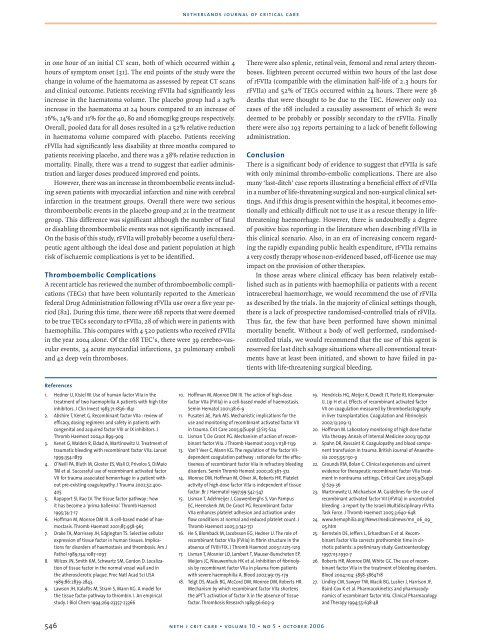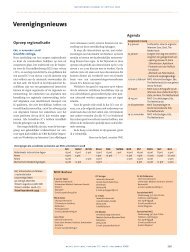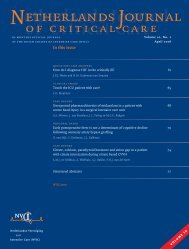Netherlands Journal
NJCC Volume 10, Oktober 2006
NJCC Volume 10, Oktober 2006
- No tags were found...
You also want an ePaper? Increase the reach of your titles
YUMPU automatically turns print PDFs into web optimized ePapers that Google loves.
netherlands journal of critical care<br />
in one hour of an initial CT scan, both of which occurred within 4<br />
hours of symptom onset [31]. The end points of the study were the<br />
change in volume of the haematoma as assessed by repeat CT scans<br />
and clinical outcome. Patients receiving rFVIIa had significantly less<br />
increase in the haematoma volume. The placebo group had a 29%<br />
increase in the haematoma at 24 hours compared to an increase of<br />
16%, 14% and 11% for the 40, 80 and 160mcg/kg groups respectively.<br />
Overall, pooled data for all doses resulted in a 52% relative reduction<br />
in haematoma volume compared with placebo. Patients receiving<br />
rFVIIa had significantly less disability at three months compared to<br />
patients receiving placebo, and there was a 38% relative reduction in<br />
mortality. Finally, there was a trend to suggest that earlier administration<br />
and larger doses produced improved end points.<br />
However, there was an increase in thromboembolic events including<br />
seven patients with myocardial infarction and nine with cerebral<br />
infarction in the treatment groups. Overall there were two serious<br />
thromboembolic events in the placebo group and 21 in the treatment<br />
group. This difference was significant although the number of fatal<br />
or disabling thromboembolic events was not significantly increased.<br />
On the basis of this study, rFVIIa will probably become a useful therapeutic<br />
agent although the ideal dose and patient population at high<br />
risk of ischaemic complications is yet to be identified.<br />
Thromboembolic Complications<br />
A recent article has reviewed the number of thromboembolic complications<br />
(TECs) that have been voluntarily reported to the American<br />
federal Drug Administration following rFVIIa use over a five year period<br />
[82]. During this time, there were 168 reports that were deemed<br />
to be true TECs secondary to rFVIIa, 28 of which were in patients with<br />
haemophilia. This compares with 4 520 patients who received rFVIIa<br />
in the year 2004 alone. Of the 168 TEC’s, there were 39 cerebro-vascular<br />
events, 34 acute myocardial infarctions, 32 pulmonary emboli<br />
and 42 deep vein thromboses.<br />
There were also splenic, retinal vein, femoral and renal artery thromboses.<br />
Eighteen percent occurred within two hours of the last dose<br />
of rFVIIa (compatible with the elimination half-life of 2.3 hours for<br />
rFVIIa) and 52% of TECs occurred within 24 hours. There were 36<br />
deaths that were thought to be due to the TEC. However only 102<br />
cases of the 168 included a causality assessment of which 81 were<br />
deemed to be probably or possibly secondary to the rFVIIa. Finally<br />
there were also 193 reports pertaining to a lack of benefit following<br />
administration.<br />
Conclusion<br />
There is a significant body of evidence to suggest that rFVIIa is safe<br />
with only minimal thrombo-embolic complications. There are also<br />
many ‘last-ditch’ case reports illustrating a beneficial effect of rFVIIa<br />
in a number of life-threatening surgical and non-surgical clinical settings.<br />
And if this drug is present within the hospital, it becomes emotionally<br />
and ethically difficult not to use it as a rescue therapy in lifethreatening<br />
haemorrhage. However, there is undoubtedly a degree<br />
of positive bias reporting in the literature when describing rFVIIa in<br />
this clinical scenario. Also, in an era of increasing concern regarding<br />
the rapidly expanding public health expenditure, rFVIIa remains<br />
a very costly therapy whose non-evidenced based, off-licence use may<br />
impact on the provision of other therapies.<br />
In those areas where clinical efficacy has been relatively established<br />
such as in patients with haemophilia or patients with a recent<br />
intracerebral haemorrhage, we would recommend the use of rFVIIa<br />
as described by the trials. In the majority of clinical settings though,<br />
there is a lack of prospective randomised-controlled trials of rFVIIa.<br />
Thus far, the few that have been performed have shown minimal<br />
mortality benefit. Without a body of well performed, randomisedcontrolled<br />
trials, we would recommend that the use of this agent is<br />
reserved for last ditch salvage situations where all conventional treatments<br />
have at least been initiated, and shown to have failed in patients<br />
with life-threatening surgical bleeding.<br />
References<br />
1. Hedner U, Kisiel W. Use of human factor VIIa in the<br />
treatment of two haemophilia A patients with high titer<br />
inhibitors. J Clin Invest 1983;71:1836-1841<br />
2. Abshire T, Kenet G. Recombinant factor VIIa : review of<br />
efficacy, dosing regimens and safety in patients with<br />
congenital and acquired factor VIII or IX inhibitors. J<br />
Thromb Haemost 2004;2:899-909<br />
3. Kenet G, Walden R, Eldad A, Martinowitz U. Treatment of<br />
traumatic bleeding with recombinant factor VIIa. Lancet<br />
1999;354:1879<br />
4. O’Neill PA, Bluth M, Gloster ES, Wali D, Privolos S, DiMaio<br />
TM et al. Successful use of recombinant activated factor<br />
VII for trauma associated hemorrhage in a patient without<br />
pre-existing coagulopathy. J Trauma 2002;52:400-<br />
405<br />
5. Rapaport SI, Rao LV. The tissue factor pathway : how<br />
it has become a ‘prima ballerina’. Thromb Haemost<br />
1995;74:7-17<br />
6. Hoffman M, Monroe DM III. A cell-based model of haemostasis.<br />
Thromb Haemost 2001;85:958-965<br />
7. Drake TA, Morrissey JH, Edgington TS. Selective cellular<br />
expression of tissue factor in human tissues. Implications<br />
for disorders of haemostasis and thrombosis. Am J<br />
Pathol 1989;134:1087-1097<br />
8. Wilcox JN, Smith KM, Schwartz SM, Gordon D. Localization<br />
of tissue factor in the normal vessel wall and in<br />
the atherosclerotic plaque. Proc Natl Acad Sci USA<br />
1989;86:2839-2843.<br />
9. Lawson JH, Kalaftis M, Stram S, Mann KG. A model for<br />
the tissue factor pathway to thrombin. I. An empirical<br />
study. J Biol Chem 1994;269:23357-23366<br />
10. Hoffman M, Monroe DM III. The action of high-dose<br />
factor VIIa (FVIIa) in a cell-based model of haemostasis.<br />
Semin Hematol 2001;38:6-9<br />
11. Pusateri AE, Park MS. Mechanistic implications for the<br />
use and monitoring of recombinant activated factor VII<br />
in trauma. Crit Care 2005;9(Suppl 5):S15-S24<br />
12. Lisman T, De Groot PG. Mechanism of action of recombinant<br />
factor VIIa. J Thromb Haemost 2003;1:1138-1139<br />
13. Van’t Veer C, Mann KG. The regulation of the factor VIIdependent<br />
coagulation pathway : rationale for the effectiveness<br />
of recombinant factor Viia in refractory bleeding<br />
disorders. Semin Thromb Hemost 2000;26:367-372<br />
14. Monroe DM, Hoffman M, Oliver JA, Roberts HR. Platelet<br />
activity of high-dose factor VIIa is independent of tissue<br />
factor. Br J Haematol 1997;99:542-547<br />
15. Lisman T, Adelmeijer J, Cauwenberghs S, Van Pampus<br />
EC, Heemskerk JW, De Groot PG. Recombinant factor<br />
VIIa enhances platelet adhesion and activation under<br />
flow conditions at normal and reduced platelet count. J<br />
Thromb Haemost 2005;3:742-751<br />
16. He S, Blomback M, Jacobsson EG, Hedner U. The role of<br />
recombinant factor VIIa (FVIIa) in fibrin structure in the<br />
absence of FVIII/FIX. J Thromb Haemost 2003;1:1215-1219<br />
17. Lisman T, Mosnier LO, Lambert T, Mauser-Bunschoten EP,<br />
Meijers JC, Nieuwenhuis HK et al. Inhibition of fibrinolysis<br />
by recombinant factor VIIa in plasma from patients<br />
with severe haemophilia A. Blood 2002;99:175-179<br />
18. Telgt DS, Macik BG, McCord DM, Monroe DM, Roberts HR.<br />
Mechanism by which recombinant factor VIIa shortens<br />
the aPTT: activation of factor X in the absence of tissue<br />
factor. Thrombosis Research 1989;56:603-9<br />
19. Hendricks HG, Meijer K, Dewdt JT, Porte RJ, Klompmaker<br />
IJ, Lip H et al. Effects of recombinant activated factor<br />
VII on coagulation measured by thromboelastography<br />
in liver transplantation. Coagulation and Fibrinolysis<br />
2002;13:309-13<br />
20. Hoffman M. Laboratory monitoring of high dose factor<br />
VIIa therapy. Annals of Internal Medicine 2003;139:791<br />
21. Spahn DR, Rossaint R. Coagulopathy and blood component<br />
transfusion in trauma. British <strong>Journal</strong> of Anaesthesia<br />
2005;95:130-9<br />
22. Grounds RM, Bolan C. Clinical experiences and current<br />
evidence for therapeutic recombinant factor VIIa treatment<br />
in nontrauma settings. Critical Care 2005;9(Suppl<br />
5):S29-36<br />
23. Martinowitz U, Michaelson M. Guidelines for the use of<br />
recombinant activated factor VII (rFVIIa) in uncontrolled<br />
bleeding : a report by the Israeli Multidisciplinary rFVIIa<br />
Task Force. J Thromb Haemost 2005;3:640-648<br />
24. www.hemophilia.org/News/medicalnews/mn_06_09_<br />
05.htm<br />
25. Bernstein DE, Jeffers L, Erhardtsen E et al. Recombinant<br />
Factor VIIa corrects prothrombin time in cirrhotic<br />
patients: a preliminary study. Gastroenterology<br />
1997;113:1930-7<br />
26. Roberts HR, Monroe DM, White GC. The use of recombinant<br />
factor VIIa in the treatment of bleeding disorders.<br />
Blood 2004;104: 3858-3864T18<br />
27. Lindley CM, Sawyer TW, Macik BG, Lusher J, Harrison JF,<br />
Baird-Cox K et al. Pharmacokinetics and pharmacodynamics<br />
of recombinant factor VIIa. Clinical Pharmacology<br />
and Therapy 1994;55:638-48<br />
546<br />
neth j crit care • volume 10 • no 5 • october 2006







